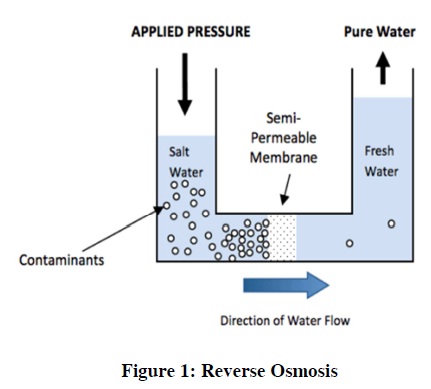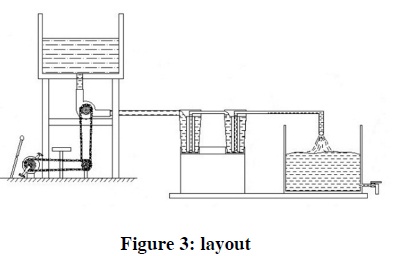





Published on Aug 21, 2023
The aim of this paper is to discover whether human powered reverse osmosis is a viable option for producing pure water. The matters at hand are to determine whether human power is enough to operate such a system, how much clean drinking water it will produce, and if it produces a reasonable amount for the work put in. Simple techniques for treating water at home, such as chlorination, filters, and solar disinfection, and storing it in safe containers could save a huge number of lives each year.
Reducing deaths from waterborne diseases is a major public health goal. A device was designed to test the practicality of this idea through a numerical analysis. The device uses a pedal to harness human motion to convert it into usable power to run a reverse osmosis filtration system. This was used to calculate the power needed to power such a design and was then compared with researched data of available power from humans. It indicated that a human could easily provide enough power to run a reverse osmosis system.
The Earth is covered by 75% water, yet one of the world’s greatest issues is a lack of drinking water. Every year, almost four million people die from water-related diseases and 98% of those occur in the developing world. In response to such a need, this idea is proposed to produce clean drinking water by reverse osmosis filtration by means of human power. There are several means to purify water; however, because of its incredible thoroughness, a reverse osmosis system has been preferentially selected for this design. According to a 2007 World Health Organization (WHO) report, 1.1 billion people lack access to an improved drinking water supply, 88 percent of the 4 billion annual cases of diarrheal disease are attributed to unsafe water and inadequate sanitation and hygiene, and 1.8 million people die from diarrheal diseases each year.The WHO estimates that 94 percent of these diarrheal cases are preventable through modifications to the environment, including access to safe water.
Osmosis is a natural process in which a liquid from a less concentrated solution flows through a semi-permeable membrane to a more concentrated solution. Pressure is applied on the more highly concentrated solution so that liquid flows from the higher concentrated solution to the lower concentrated solution.In this case the highly concentrated solution is dirty, undrinkable water. For this system, pressure is applied so that water molecules are forced through a 0.0001 micron semi-permeable membrane.

Reverse osmosis systems can often improve thequality of water. The reverse osmosis water treatmentmethod has been used extensively to convert brackishor seawater to drinking water, to clean up wastewater,and to recover dissolved salts from industrialprocesses. It is becoming more popular in the homemarket as homeowners are increasingly concernedabout contaminants that affect their health, as well asabout non-hazardous chemicals that affect the taste,odor, or color of their drinking water.
In the reverse osmosis process a cellophane-likemembrane separates purified water from contaminatedwater. Osmosis occurs whentwo solutions containing different quantities of dissolvedchemicals are separated by a semi permeablemembrane. Osmotic pressure of the dissolved chemicalcauses pure water to pass through the membranefrom the dilute to the more concentrated solution. There is a natural tendency for chemicalsto reach equal concentrations on both sides of themembrane.
To run an RO system, there needs to be a form of energy applied to force pressure through it.The issue is whether human power is actually enough to run an RO system and whether the potable water that is produced from it is effective enough for the work put in. A pedal pump was chosen to harness human power effectively because of its simplicity, widespread use, and relatively great power potential from human leg strength.
A single-speed pedal simply utilizes an extended length chain connected to the system driving gear and a few pulleys to redirect the chain to keep it riding on the gears. The pump system starts with a gear driven shaft attached to the pedal chain. The shaft turns a disk and connection rod. The pump handles are fixed to the other end of the connection rod, and the pump ends are connected directly to fittings tapped into the main tank. The diameter of the drive disk is equal to the throw of the pumps.The pump has a 120 psi capability to maintain pressure.Another pump is also used to build pressure faster to maintain pressure and for redundancy in the event of failure. The main component of the entire design is the Reverse Osmosis System. It has four different filtering stages used to purify and improve the quality of the water. The main filter in this system utilizes reverse osmosis to remove any impurities down to 0.0001 microns in size. This removes virtually any traces of metals, dust, bacteria, and viruses as it is the most thorough of filters.
The entire process of the design begins by adding salt water into the tank. All of the heavy sediment is immediately removed as the water passes through several layered mesh micron filters. The initial filtering step is crucial because the RO filter would quickly clog if it had to filter heavier sediments. The tank lid must then be sealed securely so that pressure can be built in the tank. To set the purification system in motion we need to begin pedaling the pedal. Since the pump mechanism is geared to minimize effort needed to operate it, the user feels little to no difference in having to power the pump system compared to pedal a bicycle. The water then enters the four stages of filters in the RO system.
The first stage removes any very heavy sediment down to five microns still left in the water that the first set of filters did not catch.
The second stage removes any unwanted color, taste, and odor. These two stages prepare the water for the most crucial step: reverse osmosis. Without these previous two filters, the RO membrane could easily be destroyed by certain chemicals that may be in the dirty water. The more filtered the water is before passing through the RO membrane, the longer the membrane will last.
This third stage is the heart of the system as it removes all particles down to 0.0001 micron in size.
The fourth and final stage is a repeat of the second stage, purely to optimize water quality. From here, the water exits the system as potable water and rinse water. It is important to note that only the purest water is used for drinking and that alone. The rinse water however can be used in many ways other than drinking, such as cooking, cleaning, or irrigation so that it never gets wasted.
The salt water is stored in the water tank. The salt water is taken to purifier arrangement by the help of pedal pump. The pedal is operated so that the pump operates. The pump wills the salt water from the tank to the first filter. Then the filtered water will be sent through the second filter automatically because of gravitational force. The first filter is the sedimentation filter and the second filter is the salt filter in which the salt from the water is removed and purified. After the filtering process takes place the filtered water is collected in the collecting tank.

Here we use a pedal and chain drive to operate the pump to pump the water from low level to the high level for the filtering process. It is operated and human controlled. The purifier removes the dust and unwanted particles in water. The purification process is completed after the water is collected in a separate tank. The collected water may be used for further applications.
1. It can be used in water purifying industries.
2. This technology has advantage of a membrane based process where concentration and separation is achieved without a change of state and without use of chemicals or thermal energy, thus making the process energy efficient and ideally suited for recovery applications.
Following are the advantages of the RO process that make it attractive for dilute aqueous wastewater treatment include
1. RO systems are simple to design and operate, have low maintenance requirements, and are modular in nature, making expansion of the systems easy.
2. Both inorganic and organic pollutants can be removed simultaneously by RO membrane processes.
3. RO systems allow recovery/recycle of waste process streams with no effect on the material being recovered.
4. RO systems require less energy as compared to other technology.
5. RO processes can considerably reduce the volume of waste streams so that these can be treated more efficiently and cost effectively by other processes such as incineration.
The future of the study of effective environmental engineering procedures is wide, optimistic and innovative. The optimism in research pursuits is universal amongst the scientific fraternity. Environmental engineering techniques such as membrane separation processes will be an eye opener of most of the scientific community. Man’s as well as scientist’s vision will pave way to greater acceptance of these path breaking procedures on the part of environmentalist’s point of view. The membrane separation process particularly reverse osmosis and its success will open up avenues and applications for other membrane separation processes. Hope and vision will not be further behind and it will not be an illusion. The success of these procedures lies at the hands of the environmentalist and at the hands of the environmental engineer. Vision and success in this domain is slowly opening up windows of optimism and innovation in future years to come.
The project carried out by us made an impressing task in the field of water purification method. This project has also reduced the cost involved in the concern. project has been designed to perform the entire requirement task which has also been provided.
1. Urieli, Israel. Ohio University, "Human Powered Vehicles 1." n.d. Web. 20 Mar 2011.
2. APEC, FreeDrinkingWater.com. "RO-CTOP Ultra Reverse Osmosis System." 2010. Web. 20 Mar 2011.
3. FEMA, FEMA.gov. "Water." n.d. Web. 25 Mar 2011.
4. Water.org. Water.org, Inc., "Water Crisis '09." 2009. Web. 24 Mar 2011.